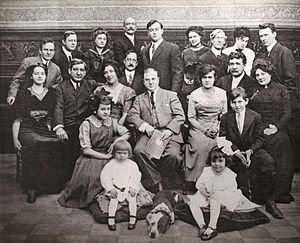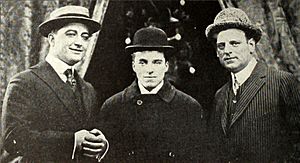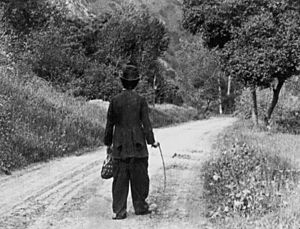Essanay Studios facts for kids
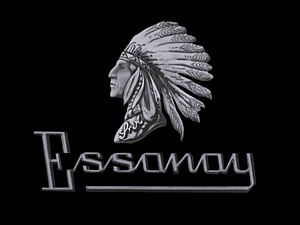
Essanay Film Manufacturing Company logo in a still frame from a Charlie Chaplin film
|
|
| Industry | Film |
|---|---|
| Successor | Warner Bros. |
| Founded | 1907 |
| Founder | George Kirke Spoor Gilbert M. Anderson |
Essanay Studios was an important early American film studio. It was officially called the Essanay Film Manufacturing Company. The studio started in Chicago in 1907. It was founded by two friends, George Kirke Spoor and Gilbert M. Anderson. The name "Essanay" comes from their initials: S for Spoor and A for Anderson.
Essanay is most famous for the funny movies it made with Charlie Chaplin. These films were created between 1915 and 1916. The studio helped shape early movies. Its founders later received special Academy Awards for their pioneering work.
Contents
Starting the Studio
| Essanay Studios Building | |
|---|---|
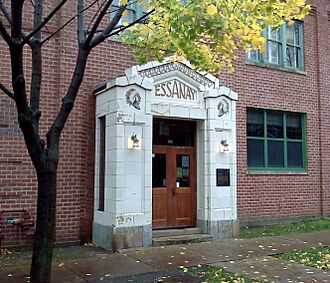 |
|
| General information | |
| Address | 1333-45 W. Argyle St, Chicago, Illinois |
| Coordinates | 41°58′21″N 87°39′50″W / 41.9724°N 87.6638°W |
| Opened | 1908 |
| Designated: | March 26, 1996 |
Essanay first opened its doors on Wells Street in Chicago. Their very first film was called An Awful Skate, or The Hobo on Rollers. It came out in July 1907. The movie starred Ben Turpin, who was the studio's janitor at the time!
This first film cost only a few hundred dollars to make. But it earned thousands of dollars when it was shown. Because of this success, the studio grew quickly. In 1908, Essanay moved to a bigger, more famous building. This new home was on W. Argyle Street in Uptown, Chicago.
Famous Actors and Crew
Essanay Studios made many silent films. They featured actors who became big stars. Some of these names include Wallace Beery, Gloria Swanson, and Francis X. Bushman.
The studio's co-owner, Gilbert Anderson, was also a popular actor. He starred in many "Broncho Billy" Western movies. But the biggest star to ever work at Essanay was Charlie Chaplin. He even had his own team to make films there.
Behind the scenes, Allan Dwan started as a writer. He later became a famous Hollywood director. Louella Parsons also wrote for Essanay. She then became a powerful Hollywood gossip columnist. Both founders, George Spoor and Gilbert Anderson, received honorary Oscars. They were recognized for their important work in early filmmaking.
What Essanay Produced
Essanay made many different kinds of movies. In 1908, they created the first American film version of A Christmas Carol. They also made a Western short film called The James Boys of Missouri. This was one of the first movies about the real-life outlaws, Jesse James and Frank James.
The first ever "pie-in-the-face" joke in a movie happened at Essanay. It hit star Ben Turpin in the 1909 film Mr. Flip. In 1916, the studio released the first American Sherlock Holmes movie. It starred William Gillette as the famous detective. Essanay also made animated comedies. These included popular cartoons about a boy named "Dreamy Dud" and his dog "Wag".
Essanay's Western Films
Chicago's weather could be tricky for filming, especially in winter. Also, Western movies were very popular. So, Gilbert Anderson took part of the company out west. They first went to Colorado to film. Anderson said Colorado was "the finest place in the country for Wild West stuff."
Later, the Western film crew moved to California. They filmed in different places, like San Rafael and Santa Barbara. In 1912, they settled in Niles Canyon near Niles. Essanay built cottages for actors and a studio there. They made over 350 films in Niles. However, this studio closed in 1916.
Charlie Chaplin's Movies
In late 1914, Essanay hired the famous comedian Charlie Chaplin. They offered him more money and his own film crew. Chaplin made fourteen short comedies for Essanay in 1915-1916. He filmed them in both Chicago and Niles.
Chaplin's Essanay films were more organized than his earlier ones. They had better stories and characters. A very important film from this time was The Tramp (1915). In it, Chaplin's character, the "Little Tramp," works on a farm. He falls in love with the farmer's daughter. This film showed sad moments mixed with comedy, which was new for slapstick movies. It ends with the famous scene of the lonely tramp walking away.
Chaplin's team at Essanay included Ben Turpin and Edna Purviance. Edna became his girlfriend off-screen. Chaplin didn't like the cold weather in Chicago or Niles. He moved his film unit to warmer Los Angeles. He left Essanay after only one year for more money and creative freedom.
His leaving caused problems for Essanay. Chaplin was their biggest money-maker. The studio tried to make "new" Chaplin comedies from old film clips. But it wasn't the same. Essanay then hired French comedian Max Linder. However, Linder's films didn't become as popular as Chaplin's in America.
Working Together: V-L-S-E
In 1915, Essanay joined with three other film studios. These were Vitagraph Studios, Lubin Manufacturing Company, and Selig Polyscope Company. They formed a group called V-L-S-E, Incorporated. This partnership helped them distribute their films. It was a way for the studios to work together and stay strong.
Black Cat Films
In 1916, Essanay made a deal to get 100 stories from The Black Cat magazine. They planned to turn these stories into short films. Each film would be about 30 minutes long. The first "Black Cat" film, "The Egg," came out in December 1916.
The Final Years
Essanay's Chicago studio kept making films until 1918. In total, they made over 1,400 movies in ten years. As a last effort to use Charlie Chaplin's fame, Essanay put together Triple Trouble. This film used old, unfinished Chaplin scenes. They added new scenes with actor Leo White to connect them.
Even though the studio said it was a new film, some people were unsure. But since new Chaplin movies were hard to find, it still found an audience. However, the money earned wasn't enough to save the company.
George K. Spoor continued to work in movies. He tried new film technologies, like a 3-D system. He passed away in 1953. G. M. Anderson became an independent producer. He helped Stan Laurel make silent comedies. Anderson died in 1971.
Today, the old Essanay building in Chicago is home to St. Augustine's College. Its main hall is even named the Charlie Chaplin Auditorium. The building was recognized as a Chicago Landmark in 1996.
See also
 In Spanish: Essanay Studios para niños
In Spanish: Essanay Studios para niños
- Chicago film industry
- Niles Essanay Silent Film Museum


